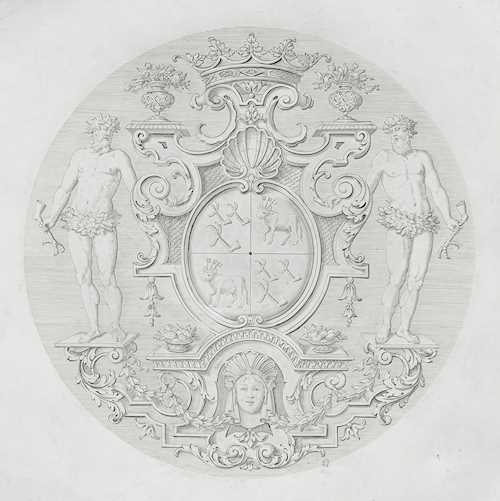
Lot 1057 - A208 Decorative Arts - Thursday, 21. March 2024, 01.30 PM
LARGE REPRESENTATIVE DISPLAY PLATE
The rather sober design of the plate is contrasted by the magnificent and fine coat of arms engraving in the center. An elaborate, symmetrically designed cartouche of rocaille, vases and floral decorations is engraved in a circle on a horizontally hatched background, flanked by two shield holders. In the middle of the cartouche is the crowned coat of arms of Melusine Baroness von der Schulenburg. From 1691, she was the mistress of the then Elector Prince Georg Ludwig (1660-1727) of Brunswick-Lüneburg. When he ascended the English throne as George I in 1714, Melusine followed her lover to England. In 1716, he bestowed upon her the non-hereditary title of Duchess of Munster, which can be traced back to the ducal crown above her coat of arms. Also in 1716, Paul de Lamerie, the maître of the plate on offer, was appointed royal goldsmith by George I. Against the backdrop of this historical context, the large representative display plate appears to have been commissioned by the English king for Melusine Baroness von der Schulenburg.
- Probably made for Melusine Baroness von der Schulenburg (1667-1743), mistress of George I, King of England
- According to tradition, in family possession since then, temporarily in Seggerde Castle
- Inherited by the current owners
Paul de Lamerie (1688-1751) is considered one of the most famous English goldsmiths of his generation and is particularly known for his ornate work in the Rococo style. He was born in 's-Hertogenbosch in what is now the Netherlands, the son of the Huguenot Paul Souchay de la Merie. In August 1703, de Lamerie was apprenticed to the Huguenot London goldsmith Pierre Platel (1659-1739) and opened his own workshop in 1713. It was at this time that he had his first of five Maker's marks used over the years registered at Goldsmith's Hall. The mark struck on the representative display plate, which Lamerie used in the years 1716-1720, differs only marginally in its formal design from this first one and was initially not included in the research literature due to the inadmissible lack of registration at Goldsmiths' Hall (see Arthur G. Grimwade: London Goldsmiths 1697-1837. Their marks and lives. London 1976 and Auss.-Kat. Paul de Lamerie. At the Sign of the Golden Ball, Goldsmiths' Hall London 1990, London 1990, p. 29). Like almost all engravings on silver, the one on the large representative display plate is not signed and any attempt at attribution can only be speculative. However, there is a clear proximity to works by William Hogarth and Ellis Gamble, both of whom designed and executed engravings on silver objects for Paul de Lamerie (see, for example, Charles Oman: "English Engravers on Plate", in: Apollo 1957, pp. 286-289). Even though surviving documents only provide evidence of an official collaboration between Lamerie and Gamble for the years 1723-1728, an earlier collaboration is certainly conceivable.
We would like to thank Prof. Dr. Peter Kurrild-Klitgaard, Secretary General of the Académie international d'heraldique, for his assistance in identifying the coat of arms.
CHF 8 000 / 12 000 | (€ 8 250 / 12 370)
Sold for CHF 70 000 (including buyer’s premium)
All information is subject to change.




